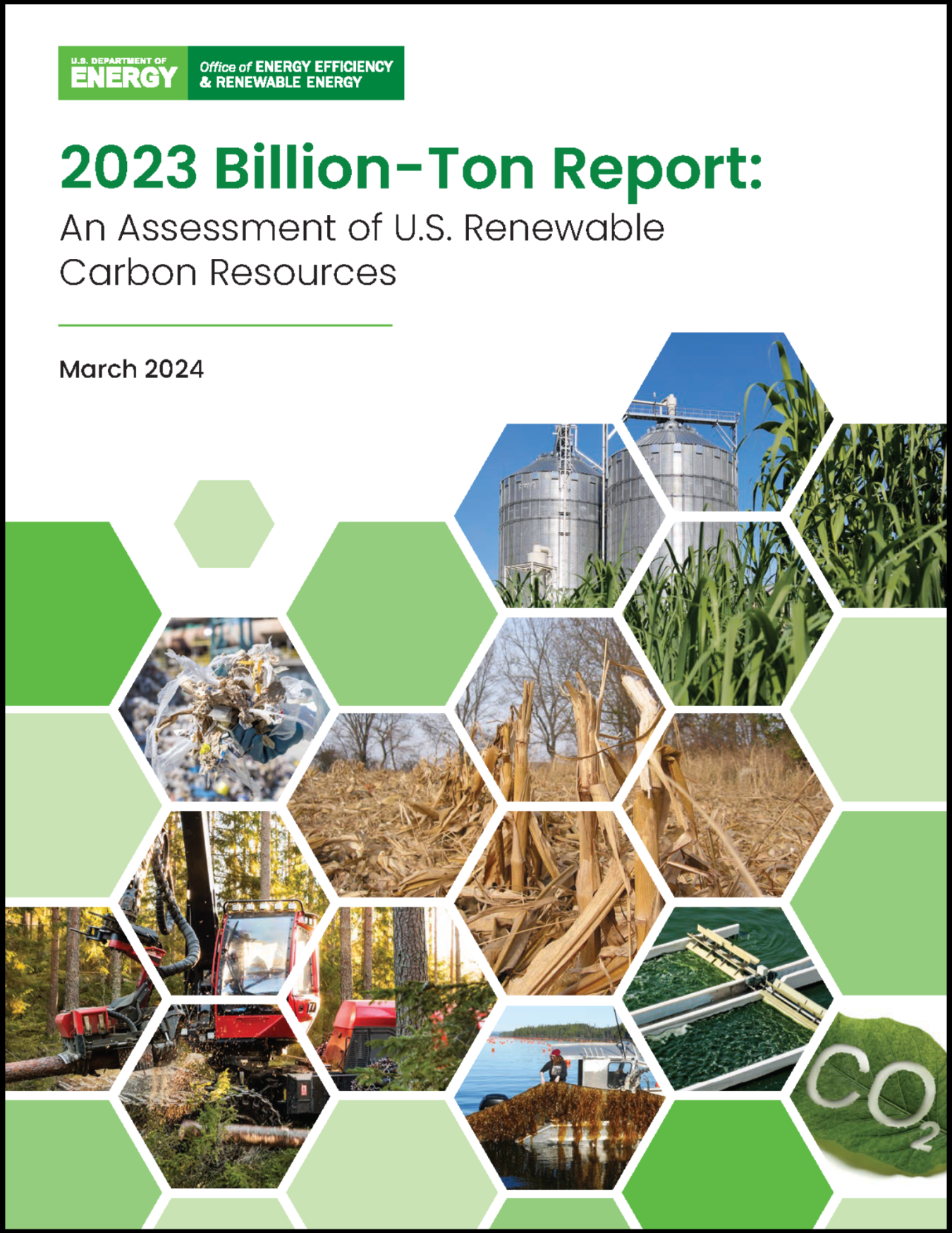The U.S. Department of Energy (DOE) recently released a robust analysis, the 2023 Billion-Ton Report (BT23), showcasing how America could sustainably triple its production of biomass to more than 1 billion tons per year while still meeting the projected demand for food, feed, fiber, conventional forest products, and exports. The impact of this comprehensive analysis is far-reaching and DOE Bioenergy Technologies Office (BETO) Technology Manager, Dr. Mark Elless, managed the development of BT23 which was led by Oak Ridge National Laboratory.
April 9, 2024
The U.S. Department of Energy (DOE) recently released a robust analysis, the 2023 Billion-Ton Report (BT23), demonstrating how America could sustainably triple its production of biomass to more than 1 billion tons per year while still meeting the projected demand for food, feed, fiber, conventional forest products, and exports.
BT23 is the fourth in a series of national biomass resource assessments since 2005. The report identifies feedstocks that could be available to produce biofuels to decarbonize transportation and industrial processes. The impact of this comprehensive analysis is far-reaching and DOE Bioenergy Technologies Office (BETO) Technology Manager, Dr. Mark Elless, managed the development of BT23 which was led by Oak Ridge National Laboratory.
“It is the seminal report for BETO and it’s nice to be associated with an assessment that’s widely cited and widely used,” said Dr. Elless.

2023 Billion-Ton Report: Decarbonizing Aviation
Notably, this report assesses the potential for the United States to produce enough biomass required for the production of sustainable aviation fuel (SAF). SAF is made from renewable biomass and waste resources and could deliver the same performance as petroleum-based jet fuel with a fraction of its carbon footprint, giving airlines solid footing for reducing greenhouse gas emissions from flight.
BT23 finds that the United States can sustainably produce over 1 billion tons of biomass, satisfying over 100% of the 2050 projected demand for airplane fuel in the country and allowing the U.S. to decarbonize the aviation industry with SAF. DOE is working with the U.S. Department of Transportation, the U.S. Department of Agriculture, and other federal agencies to implement a comprehensive strategy for scaling up new technologies to produce SAF on a commercial scale through the SAF Grand Challenge, which aims to reduce life cycle greenhouse gas emissions from SAF by 50% compared to conventional fuel.
“For the SAF Grand Challenge, we need 35 billion gallons per year by 2050, which equates to about 650 million tons of biomass. Therefore, if we have a billion tons of biomass, we will certainly have leftover biomass to use in other fuels or products. That’s what we’re really working toward. We’re trying to displace as much of the petroleum counterparts as we can to reduce greenhouse gas emissions,” said Dr. Elless.

BT23 Key Findings and Impacts
Key findings of BT23 indicate that with potential biomass production, the U.S. could generate an estimated 60 billion gallons of low greenhouse gas liquid fuels. Currently untapped biomass resources alone could contribute an additional 350 million tons annually, effectively doubling the U.S. bioeconomy. The analysis ensures sustainable outcomes by accounting for potential risks to soil, air and water quality, water availability, and the imperative to protect America’s forests and biodiversity.
“It provides a great resource to our stakeholders, said Dr. Elless. “We want to emphasize that this is a projection that depends on future market maturity—not a prediction—but it gives some indication of where in the U.S. we can grow a billion tons of biomass—and it’s not all from one resource.”
The BT23 report analyzes the biomass production capacity of approximately sixty resources, several of which have never before been the subject of a DOE Billion-Ton assessment. These include winter oilseed crops, trees and brush harvested from forests to prevent wildfires, macroalgae such as seaweed cultivated in ocean farms, and carbon dioxide from industrial plants. Projections suggest that future advancements could unlock even more potential, with energy crops alone potentially yielding over 400 million additional tons per year.
“Energy crops are such a big component of the billion-ton projection,” said Dr. Elless. “Without energy crops, we don’t get there. So, we really must develop and deploy them wherever we can. If we can also lower carbon intensity and increase soil carbon, then it’s a win-win.”
The report highlights the importance of diversifying biomass sources and includes detailed insights into biomass production capacity at the county, regional, and national level as shown on the Bioenergy Knowledge Discovery Framework. It indicates the need for strategic planning and investment to support the growth of both rural and urban bioeconomies. Learn more about the 2023 Billion-Ton Report here.
Sustainability and Analysis: Dr. Elless’ Portfolio and BETO Impact
Dr. Elless has an extensive science background and received a B.S. degree in Geology and a M.S. degree in Soil Science from North Dakota State University, as well as a Ph.D. in Soil Science from the University of Maryland. He completed his postdoctoral training at Oak Ridge National Laboratory (ORNL) cleaning up uranium contaminated soils at a facility just outside Cincinnati, Ohio.
“It was a good opportunity for me to learn. I learned a lot about radionuclides and wrote a book chapter on it. That got me into the environmental aspect of soils,” said Dr. Elless.
After his time at ORNL, he worked as a soil scientist at a company in New Jersey doing phytoremediation, which uses plants to clean up heavy metals like lead, arsenic, and zinc in soils and waters. As the biofuels market grew, he eventually won a grant and worked for Edenspace Systems Corporation as Director of Grants and Technology, which focused on the engineering of lignocellulosic biomass for enhanced biofuel production. Prior to joining BETO in 2012, Dr. Elless was the Grants and Alliances Manager at FuturaGene, which focused on the development of woody biomass for biofuel production.
Dr. Elless spearheaded the release of the Billion Ton 2016 Report, BT23, and the release of the annual state of technology reports concerning the delivered costs for both woody and herbaceous biomass to biorefineries. Dr. Elless also noted the best use of biomass analysis that comes out of Oak Ridge as a significant resource for BETO.
Dr. Elless also works with the Feedstock-Conversion Interface Consortium (FCIC) where he oversees projects on feedstock variability and pre-processing. Funded and led by BETO, the FCIC is a consortium of researchers at nine national laboratories dedicated to reducing the risk of biorefinery scale-up.
“FCIC was set up to help make improvements after issues with biomass handling at biorefineries became known. We now have conversion standards and a good toolbox on what is necessary to achieve flowability,” said Dr. Elless.
Dr. Elless continues to work on projects centered on analysis and sustainability. BT23 serves as a foundational assessment that will help the U.S. tackle the climate crisis and support the whole-of-government approach to achieving net-zero emissions by 2050.
Register for a virtual BT23 Webinar on Tuesday, April 16, 2024, from 1:30 pm – 2:30 pm ET to learn more about key findings of the report and its significance to the economy, environment, and industry.

